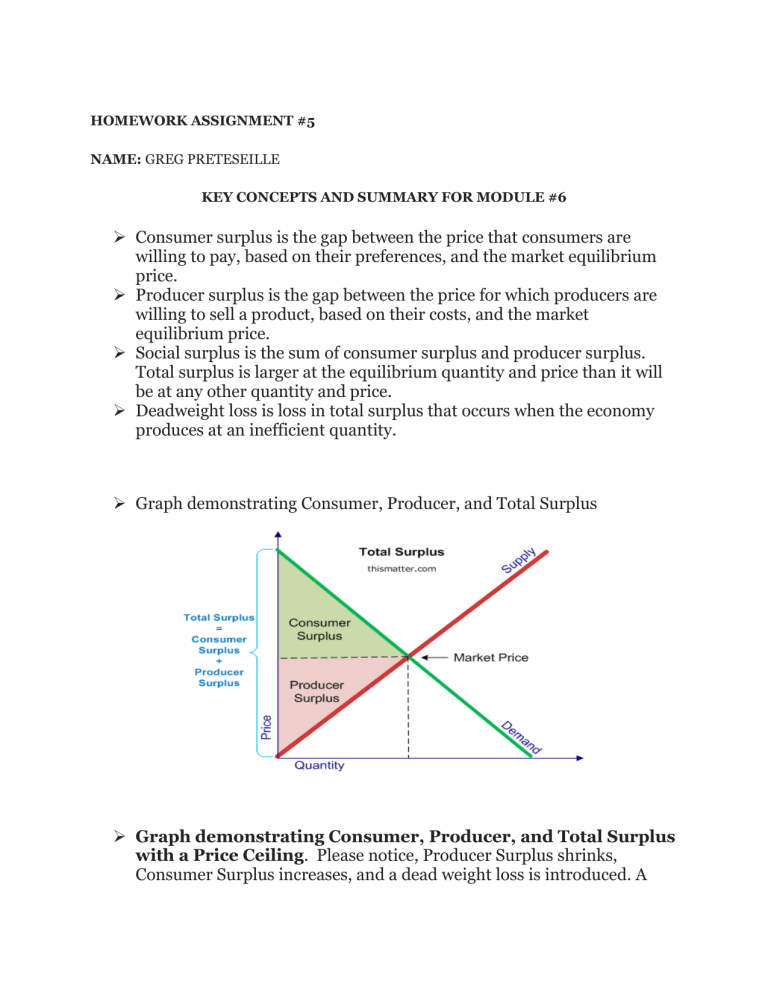
HOMEWORK ASSIGNMENT #5 NAME: GREG PRETESEILLE KEY CONCEPTS AND SUMMARY FOR MODULE #6 Consumer surplus is the gap between the price that consumers are willing to pay, based on their preferences, and the market equilibrium price. Producer surplus is the gap between the price for which producers are willing to sell a product, based on their costs, and the market equilibrium price. Social surplus is the sum of consumer surplus and producer surplus. Total surplus is larger at the equilibrium quantity and price than it will be at any other quantity and price. Deadweight loss is loss in total surplus that occurs when the economy produces at an inefficient quantity. Graph demonstrating Consumer, Producer, and Total Surplus Graph demonstrating Consumer, Producer, and Total Surplus with a Price Ceiling. Please notice, Producer Surplus shrinks, Consumer Surplus increases, and a dead weight loss is introduced. A dead weight loss can be applied to any deficiency caused by an inefficient allocation of resources. Price ceilings, such as price controls and rent controls; price floors, such as minimum wage and living wage laws; and taxation can all potentially create deadweight losses. Graph demonstrating Consumer, Producer, and Total Surplus with a Price Floor. Please notice, Producer Surplus increases, Consumer Surplus shrinks, and a dead weight loss is introduced. A dead weight loss can be applied to any deficiency caused by an inefficient allocation of resources. Price ceilings, such as price controls and rent controls; price floors, such as minimum wage and living wage laws; and taxation can all potentially create deadweight losses. Consumer Surplus Questions – Be sure to watch the videos in D2L content 1. Erika is walking around a big department store when she finds a shirt that she really loves. The price tag is torn off, so she can’t find the price. She decides that as long as the shirt is less than $40, she will buy it. When she goes to the register, she discovers that the shirt originally cost $40, but it’s on sale for $32. Which of the following is true about Erika’s consumer surplus. a. If Erika buys the shirt, she will have a consumer surplus of $32. b. Erika should not buy the shirt because her consumer surplus would be -$10. c. If Erika buys the shirt, she will have a consumer surplus of $18. d. If Erika buys the shirt, she will have a consumer surplus of $10. e. If Erika buys the shirt, she will have a consumer surplus of $8. Customer Ice Cream Arya $8 Bran $5 Cersei $4 Daenerys $2 The table above shows reservation prices for ice cream cones for individual consumers. Each consumer is only interested in buying one ice cream cone. The price of an ice cream cone is $3. Use this information to answer the questions 2- 4. 2. How many people will buy ice cream? 3 PEOPLE 3. What is Bran’s consumer surplus? $2 4. If these people make up the entire market, what is consumer surplus in the market for ice cream? (HINT: Add up Arya’s, Bran’s, and Cersei” consumer surplus) $8 5. What is consumer surplus in this market if the price is $60? To do this, please compute the area of the triangle below the demand curve and above the $60 price i.e. the blue triangle. Please use the formula for triangles: ½ Base times height .5*(150-60)*30= $2,400 6. What is consumer surplus in this market if the price is $30? To do this, please compute the area of the triangle below the demand curve and above the $30 price i.e. the blue triangle below. Please use the formula for triangles: ½ base times height .5*(150-30)*40= $1,800 Producer Surplus - Be sure to watch the videos in D2L content 7. Karen decides that as long as someone is willing to pay more than $100, she’ll sell her couch on Craigslist. She lists her couch for $300, and the next day someone calls her up and offers her $250. a. b. c. d. e. If Karen sells her couch, she will have a producer surplus of $250. Karen should not sell her couch because she will make a loss of $50. If Karen sells her couch, she will have a consumer surplus of $250. If Karen sells her couch, she will have a consumer surplus of $150. If Karen sells her couch, she will have a producer surplus of $150. Seller Seller’s Reservation Price Alex $12 Piper $16 Daya $22 Red $30 8. See chart above. Four different students have one textbook each that they are considering selling back to the bookstore after the semester ends. The table above shows each student’s reservation price, or the lowest price at which they would be willing to sell the book. The bookstore is buying textbooks at a price of $25. Use this information to answer the following questions. a. How many of the students will agree to sell their textbooks? Answer: 3 people b. What is Alex’s producer surplus? Answer: $13 c. If these students make up the entire market, what is producer surplus in the market for textbooks? Answer: $25 Note: 13+9+3=25 9. Use the graph above to calculate producer surplus at a price of $20. To do this, please compute the area of the triangle above the supply curve and underneath the $20 price i.e. the blue triangle above. Please use the formula for triangles: ½ base times height . .5*(20)*(20)= 200 10. Use the graph above to calculate producer surplus at a price of $30. To do this, please compute the area of the triangle above the supply curve and underneath the $20 price i.e. the blue triangle above. Please use the formula for triangles: ½ base times height Please be sure to look at the Y-intercept. .5*(20)*(20)= 200 Please use the graph below to answer question 11 - 13: 11. Which of the following area(s) represent producer surplus when the price is equal to P2? A) D, E, and F B) B and C C) D and E D) A, B, and C 12. Which of the following area(s) represent consumer surplus when the price is equal to P2? a. b. c. d. D, E, and F B and C D and E A, B, and C 13. Which of the following area(s) represent consumer surplus when the price is equal to P3? a. b. c. d. F A, B and C C and E A, B, and D 14. Which of the following area(s) represent deadweight loss if the price is set to P1? a. b. c. d. A A, B and C C and E B, D and F 15. Refer to Figure 7-24. If the government imposes a price floor at $18, then consumer surplus is a. ABF. b. AGH. c. HGCD. d. HGBF.




